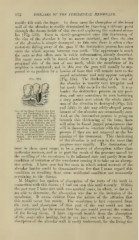Page 962 - My FlipBook
P. 962
972 DISEASES OF THE PERIDENTAL MEMBRANE.
readily felt with the finger. In these cases the absorption of the inner
wall of the alveolus is readily determined by thrusting a delicate poir.t
through the tissues inside of this rim and exploring the widened alveo-
lus (Fig. 523). Even in slowly-progressive cases this thickening of
the rim of the alveolus is by no means constant, and then the rim
of the alveolus is simply destroyed ; in this case there is often a cha-
racteristic falling away of the gum if the destructive process has eaten
awav the whole septum between two teeth. The appearance is much
the same as that often seen in calcic inflammation, already described.
But many cases will be found where there is a deep pocket on the
proximal side of the root of one tooth, while the membrane of its
neighbor is uninjured ; and in this case the gum will usually be sup-
ported in its position by a lamina of bone that will remain next to the
sound membrane and may appear complete
Fk;. o'24. (Fig. 524). The thickening of the rim of
the alveolus is usually very irregular and
but rarely fully encircles the tooth. It may
border the destructive process in any posi-
tion, and may sometimes be seen bordering
a deep pocket over which the whole thick-
ness of the alveolus is destroyed (Figs. 521
and 524); in this way oddly-shaped prom-
i»ences of the alvcolus are occasionally seen.
"^ZfaM twcLnini of 'Ihe-Ror:
(1 rs of the Lost Portion from And, as the destructivc proccss is ffoiup; on
Phagedetiic Perieeiuentilis. It , ', ^,. .i-i • p l^ i i
will be observed that only half l)eneatli tliis tliickenuig ot the Doiie, there
McSidl'^s'desiV'ovId- th'rpl:" will often be found jagged prominences that
^^J^^s^X^l^^^l ^^'^11 "^ themselves interfere with the healing
the bone immediately adjacent proCCSS if thcv are UOt rcmOVcd at the bc-
to the sound membrane is main- ^ . . o ^ mi • i • i
tained. Also note tlie sel)aration ginUHlg OI the treatment. ilUS thickcmng
oyhe teeth. ,< on.pare with Fig.
^^ ^^^ alvColuS is UOt SCCU iu the CaSCS that
progress very rapidly. The destruction of
bone in the.se cases seems to be a process of absorption rather tlian
molecular necrosis, and is in part the result of the pressure caused by
the swelling of the membrane in its inflamed state and partly from the
condition of irritation of the membrane causing it to take on an absorp-
tive action. I have seen but few cases in Avhich actual necrosis of the
alveolar border could be determined—so few that I must regard this
condition as resulting from some accidental condition not necessarily
pertaining to the disease.
]M. iSIagitot has spoken of absorption of the roots of the teeth in
connection with this disease ; I had not seen this until recently. Within
the past year I have met with two marked cases, in which, so for as I
am able to determine, the absorption Mas due to the irritation of the
membrane. It seems evident from the nature of the aflection that
this would occur l)ut rarely. The membrane is first separated from
the root, and absor])tion of that part of the root could not take
place afterward, for the reason that the pus would prevent the contact
of tiie living tissue. I have expected trouble from the absorption
of the roots after healing, but as yet have met with no cases. Tlie
absorption of the alveolar wall is easily understood, for the living tis-


